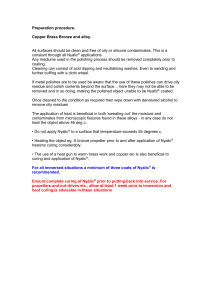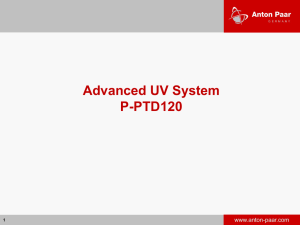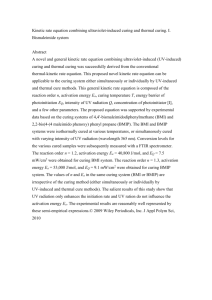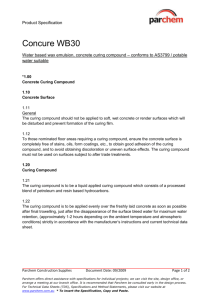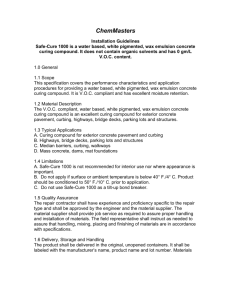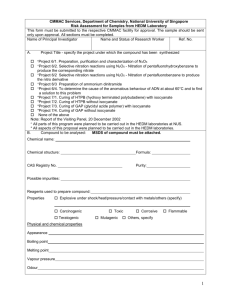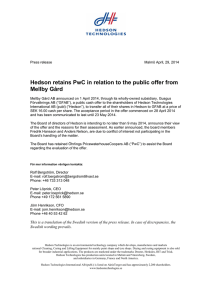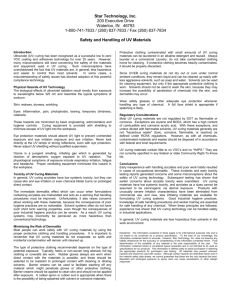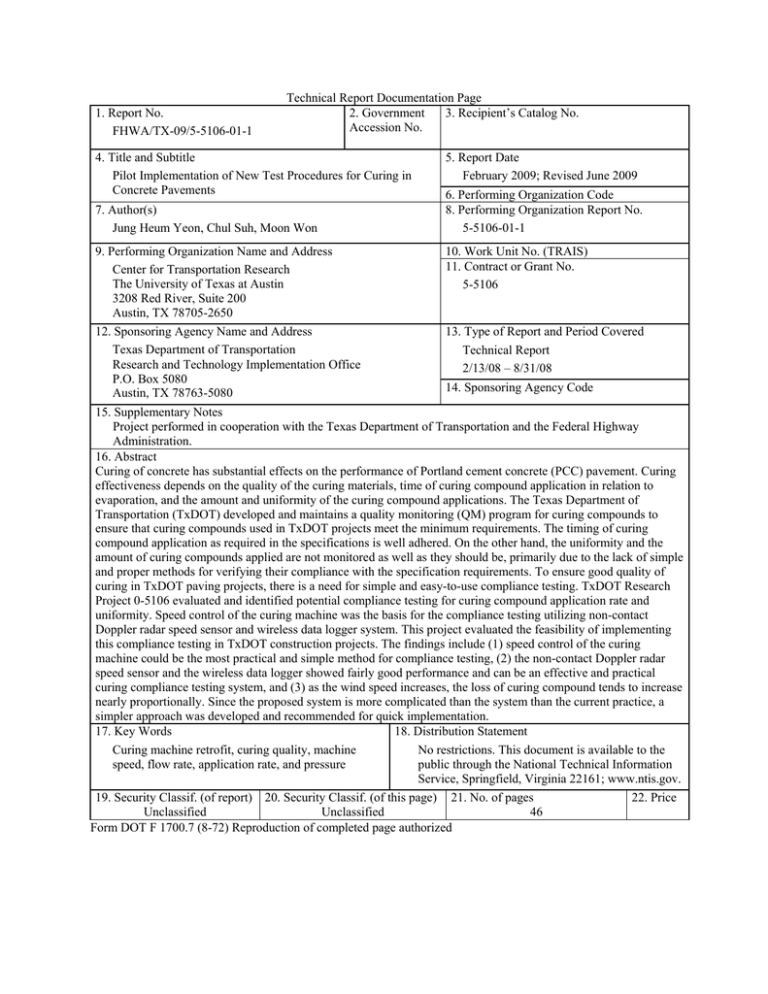
1. Report No.
FHWA/TX-09/5-5106-01-1
Technical Report Documentation Page
2. Government
3. Recipient’s Catalog No.
Accession No.
4. Title and Subtitle
Pilot Implementation of New Test Procedures for Curing in
Concrete Pavements
7. Author(s)
Jung Heum Yeon, Chul Suh, Moon Won
5. Report Date
February 2009; Revised June 2009
6. Performing Organization Code
8. Performing Organization Report No.
5-5106-01-1
9. Performing Organization Name and Address
Center for Transportation Research
The University of Texas at Austin
3208 Red River, Suite 200
Austin, TX 78705-2650
10. Work Unit No. (TRAIS)
11. Contract or Grant No.
5-5106
12. Sponsoring Agency Name and Address
Texas Department of Transportation
Research and Technology Implementation Office
P.O. Box 5080
Austin, TX 78763-5080
13. Type of Report and Period Covered
Technical Report
2/13/08 – 8/31/08
14. Sponsoring Agency Code
15. Supplementary Notes
Project performed in cooperation with the Texas Department of Transportation and the Federal Highway
Administration.
16. Abstract
Curing of concrete has substantial effects on the performance of Portland cement concrete (PCC) pavement. Curing
effectiveness depends on the quality of the curing materials, time of curing compound application in relation to
evaporation, and the amount and uniformity of the curing compound applications. The Texas Department of
Transportation (TxDOT) developed and maintains a quality monitoring (QM) program for curing compounds to
ensure that curing compounds used in TxDOT projects meet the minimum requirements. The timing of curing
compound application as required in the specifications is well adhered. On the other hand, the uniformity and the
amount of curing compounds applied are not monitored as well as they should be, primarily due to the lack of simple
and proper methods for verifying their compliance with the specification requirements. To ensure good quality of
curing in TxDOT paving projects, there is a need for simple and easy-to-use compliance testing. TxDOT Research
Project 0-5106 evaluated and identified potential compliance testing for curing compound application rate and
uniformity. Speed control of the curing machine was the basis for the compliance testing utilizing non-contact
Doppler radar speed sensor and wireless data logger system. This project evaluated the feasibility of implementing
this compliance testing in TxDOT construction projects. The findings include (1) speed control of the curing
machine could be the most practical and simple method for compliance testing, (2) the non-contact Doppler radar
speed sensor and the wireless data logger showed fairly good performance and can be an effective and practical
curing compliance testing system, and (3) as the wind speed increases, the loss of curing compound tends to increase
nearly proportionally. Since the proposed system is more complicated than the system than the current practice, a
simpler approach was developed and recommended for quick implementation.
17. Key Words
18. Distribution Statement
Curing machine retrofit, curing quality, machine
No restrictions. This document is available to the
speed, flow rate, application rate, and pressure
public through the National Technical Information
Service, Springfield, Virginia 22161; www.ntis.gov.
19. Security Classif. (of report) 20. Security Classif. (of this page) 21. No. of pages
Unclassified
Unclassified
46
Form DOT F 1700.7 (8-72) Reproduction of completed page authorized
22. Price
Pilot Implementation of New Test Procedures for Curing in
Concrete Pavements
Jung Heum Yeon
Chul Suh
Moon Won
CTR Technical Report:
Report Date:
Project:
Project Title:
Sponsoring Agency:
Performing Agency:
5-5106-1
February 2009, Revised June 2009
5-5106-01
Pilot Implementation of New Test Procedures For Curing in Concrete
Pavements
Texas Department of Transportation
Center for Transportation Research at The University of Texas at Austin
Project performed in cooperation with the Texas Department of Transportation and the Federal Highway
Administration.
Center for Transportation Research
The University of Texas at Austin
3208 Red River
Austin, TX 78705
www.utexas.edu/research/ctr
Copyright (c) 2009
Center for Transportation Research
The University of Texas at Austin
All rights reserved
Printed in the United States of America
Disclaimers
Author's Disclaimer: The contents of this report reflect the views of the authors, who
are responsible for the facts and the accuracy of the data presented herein. The contents do not
necessarily reflect the official view or policies of the Federal Highway Administration or the
Texas Department of Transportation (TxDOT). This report does not constitute a standard,
specification, or regulation.
Patent Disclaimer: There was no invention or discovery conceived or first actually
reduced to practice in the course of or under this contract, including any art, method, process,
machine manufacture, design or composition of matter, or any new useful improvement thereof,
or any variety of plant, which is or may be patentable under the patent laws of the United States
of America or any foreign country.
Notice: The United States Government and the State of Texas do not endorse products or
manufacturers. If trade or manufacturers' names appear herein, it is solely because they are
considered essential to the object of this report.
Engineering Disclaimer
NOT INTENDED FOR CONSTRUCTION, BIDDING, OR PERMIT PURPOSES.
Project Engineer: Moon Won
Professional Engineer License State and Number: Texas No. 76918
P. E. Designation: Research Supervisor
v
Acknowledgments
The authors express sincere expression to Ms. Jennifer Moore, who provided valuable
comments as the implementation director of this project, and other project monitoring committee
members, who have provided valuable advices and suggestions. Also, the research team would
like to acknowledge TxDOT Austin and Lubbock Districts for their invaluable supports.
vi
Table of Contents
Chapter 1. Introduction................................................................................................................ 1
1.1 Background ............................................................................................................................1
1.2 Objectives ..............................................................................................................................1
1.3 Scope ......................................................................................................................................2
Chapter 2. Field Compliance Testing Program ......................................................................... 3
2.1 Overview ................................................................................................................................3
2.2 Curing Machine Retrofit ........................................................................................................3
2.3 Field Testing ..........................................................................................................................7
2.4 Further Discussion ...............................................................................................................15
Chapter 3. Summary and Recommendations .......................................................................... 19
References .................................................................................................................................... 21
Appendix A: Special Provision to Item 360 .............................................................................. 23
Appendix B: Training Manual .................................................................................................. 25
B.1 Overview .............................................................................................................................25
B.2 Hardware Modification .......................................................................................................25
B.3 Flow Rate Evaluation ..........................................................................................................27
B.4 Maximum Allowable Curing Machine Speed.....................................................................30
B.5 Curing Machine Speed Evaluation......................................................................................31
B.6 Compliance Evaluation .......................................................................................................32
B.7 Summary .............................................................................................................................33
vii
viii
List of Figures
Figure 2.1: NDRSS retrofitted in curing machine .......................................................................... 5
Figure 2.2: Wireless communication data logger ........................................................................... 6
Figure 2.3: Wireless modem ........................................................................................................... 6
Figure 2.4: Wireless communication based speed measurement system ....................................... 7
Figure 2.5: Real-time data acquisition system ................................................................................ 7
Figure 2.6: Flow rate testing ......................................................................................................... 10
Figure 2.7: Plate spray testing....................................................................................................... 12
Figure 2.8: Plate spray test results and calculated values of Austin project ................................. 14
Figure 2.9: Plate spray test results and calculated values of Lubbock project ............................. 14
Figure 2.10: Wind speed vs. loss of curing compound ................................................................. 15
Figure 2.11: Speed controller ........................................................................................................ 17
Figure B.1: NDRSS retrofitted in curing machine........................................................................ 26
Figure B.2: Data logger with wireless modem ............................................................................. 26
Figure B.3: Overview of retrofitted curing machine .................................................................... 27
Figure B.4: Flow rate testing ........................................................................................................ 28
Figure B.5: Relationship between curing machine speed and application rate ............................ 30
Figure B.6: Speed controller ......................................................................................................... 31
Figure B.7: Example of application rate data over elapsed time .................................................. 33
ix
x
List of Tables
Table 2.1: Information of testing sites ............................................................................................ 8
Table 2.2: Information of curing machines..................................................................................... 8
Table 2.3: Flow rate testing (Austin, TX) ..................................................................................... 10
Table 2.4: Flow rate testing (Lubbock, TX) ................................................................................. 11
Table 2.5: Plate spray testing results (Austin, TX) ....................................................................... 13
Table 2.6: Plate spray testing results (Lubbock, TX): .................................................................. 13
Table B.1: Example of flow rate calculation ................................................................................ 29
xi
xii
Chapter 1. Introduction
1.1 Background
The importance of curing on the long-term performance of portland cement concrete
(PCC) pavement has been well known. State highway agencies (SHAs) have recognized this and
efforts have been made to improve the effectiveness of their curing operations. However, one of
the shortcomings of the current practice is the difficulty of verifying the actual curing compound
application rate. The Texas Department of Transportation (TxDOT) recognized a need to verify
the compliance of its curing operations with specification requirements. Therefore, TxDOT
sponsored a three-year research study on curing (0-5106) that terminated in August, 2007.
Project 0-5106 concentrated on two aspects of curing for PCC pavement construction. One
aspect was to improve the testing method for curing materials and develop a testing protocol for
proper evaluation of the quality of the curing materials. The other aspect was to develop better
and improved methods for checking the compliance of curing compound applications in the field
with specification requirements. Implementation project 5-5106-01 concentrated on the
implementation of the findings of the latter.
To obtain the best properties of concrete for a given quality of concrete, curing operations
have to satisfy the following conditions:
1) Curing compounds should be of good quality, and
2) Sufficient amounts of curing compounds must be applied uniformly before the
surface becomes dry.
Specifications and testing procedures have been in place to ensure that the above two
requirements are met. TxDOT administers a quality monitoring (QM) program for curing
materials. Contractors normally apply curing compounds as soon as tining operations are
completed, since carpet drag, tining, and curing compound applications are done with one
machine, and it’s advantageous to perform all three operations consecutively from the
contractor’s productivity standpoint. During curing operations, it is important to ensure that
sufficient amounts of curing compounds are applied uniformly. Currently, there is no effective
compliance test available that enables TxDOT to accurately estimate the rate of curing
compound applied and its uniformity. At the same time, under the current curing operations, it is
difficult for contractors to keep track of how much curing compound they are applying. The goal
of the implementation project, 5-5106-01 was to assist both TxDOT and contractors in
improving the effectiveness of the curing operations.
The implementation of new specifications could improve the overall performance of PCC
pavements in Texas.
1.2 Objectives
The primary objective of this study was to evaluate the feasibility of implementing new
compliance testing procedures for curing operation of concrete pavements in TxDOT
construction projects. The anticipated benefits of this implementation study are to ensure the
quality of curing operations so as to achieve proper concrete properties and to improve the
overall performance of PCC pavements in the state of Texas. Also, if successful, new procedures
1
could make it simpler and more effective for TxDOT to verify the compliance with
specifications.
In order to achieve the project goals, the following four main tasks were undertaken:
1) Retrofit a curing machine with hardware for speed and pressure measurement.
2) Verify the accuracy of curing compound application rates and uniformity.
3) Develop and improve shadow specifications.
4) Implement shadow specifications in TxDOT projects.
1.3 Scope
This implementation encompassed several phases beginning with problem recognition on
the current curing procedures being used in Texas and developing a special provision for the
pavement construction procedures to ensure the curing effectiveness.
To identify potential problems in the current curing procedures, field evaluations were
made at two different locations to investigate the influencing parameters such as application rate,
pressure, flow rate, and speed of a curing machine, which might affect the curing quality. Along
with those parameters, climatic conditions, specifically wind speed, air temperature, ambient
relative humidity, and concrete temperature were also measured using a weather station to
observe their effect on curing effectiveness. Ultimately, the measured data was analyzed in a
proper manner and compared with the specification requirements.
2
Chapter 2. Field Compliance Testing Program
2.1 Overview
As described earlier, four major tasks were conducted in this implementation project in
order to field-test a special provision for effective curing procedures. The detailed activities
conducted in each task are described as follows:
Task 1: Retrofit a curing machine with hardware for speed and pressure measurement.
In this task, a curing machine was retrofitted with hardware that measures the speed of a
curing machine, actual rate of curing compound application, and flow rate at nozzles. For this
part of the implementation project, investigations were made on the curing sections located at
two different construction projects, one in Austin and the other in Lubbock, under support from
the TxDOT and project contractors.
The hardware installed in the curing machine included a device that measures the speed
of curing machine movements. Typical curing machines used in Texas have a fixed pressure
level and it was quite difficult to vary pressure level. No effort was made to vary pressure of
curing compound in the curing machine.
Task 2: Verify the accuracy of curing compound application rates and uniformity.
A curing machine retrofitted in Task 1 was thoroughly evaluated for the accuracy of the
data from the machine on curing compound application rates and uniformity. To achieve this, socalled “plate spray testing” was performed to accurately evaluate the actual curing compound
application rate. To examine the uniformity of curing compound application, flow rate at each
nozzle was also measured.
Task 3: Improve shadow specifications.
Shadow specifications developed under 0-5106 could be modified to better accommodate
the retrofitted curing machine. Based on the results from the above two tasks, improved shadow
specifications were developed. In improving shadow specifications, the research team kept in
mind that the success of this project depends on both the simplicity of the suggested curing
operations and the accuracy of the information from the retrofitted curing machine.
Task 4: Implement shadow specifications in TxDOT projects.
The shadow specifications were implemented on a project in Lubbock, Texas. Once the
implementation of the shadow specifications was completed, its effectiveness was evaluated.
2.2 Curing Machine Retrofit
During the research study 0-5106, discussions were made among researchers and PMC
members regarding the best compliance testing for curing operations. Based on theoretical
analysis and practical consideration, it was agreed that the control of curing machine speed could
be the best option for compliance testing. Efforts were made to identify the most efficient way of
measuring curing machine speed. This section describes the work conducted in this regard.
The speed of a curing machine is one of the most significant parameters that determine
the application rate of curing compound on concrete pavements; if speed is too fast, inadequate
3
thickness of curing membrane will be formed on the pavement surface while a slower speed will
provide a thicker layer of curing membrane, thus producing better curing of concrete. From the
contractor’s standpoint, slow speed means reduced production rate and possibly higher curing
compound material cost. Accordingly, there could be a natural tendency to speed up the curing
machine speed to a speed where the application rates do not meet the specifications any more.
Currently, the speed of the curing machine is controlled by the operator based on “perceived”
satisfactory color of the sprayed curing membrane. In other words, current state of curing
machine operation is highly dependent on the operator without reasonable operational guidance.
When single piece tie bars are used, curing machine operators quite often pay more attention to
the proper direction of the curing machine so that it does not hit tie bars than the machine speed
or proper curing compound applications.
Considering actual PCC pavement construction operations, effort was made to identify a
speed sensor system that is robust and simple to operate and is capable of providing accurate
information. Several candidate speed sensor systems were identified.
The first candidate was a commercial GPS unit. Various types of GPS units that support
data logging such as speed, location (coordinates), and time were available, but it was judged
that the GPS unit was not an appropriate candidate for this project due to the following reasons:
1) Very low resolution,
2) Relatively high cost, and
3) Complex setup procedures for data logging.
The next candidate was a mechanical encoder that measures distance by using a signal
from transmission and/or axle of the curing machine. Since this option measures speed based on
the actual movement of components of a curing machine, it was anticipated to provide accurate
speed data. However, the critical shortcoming of this option was that it would require electrical
and mechanical modifications of a curing machine. Considering the complex nature of this
option, the mechanical encoder was eliminated from the list of potential candidates.
As the last probable candidate, a speed sensor which utilizes the Doppler Effect was
evaluated. It had advantages in the following aspects:
1) Accurate (Digital pulse output = 100 pulses per 1 mph),
2) Relatively inexpensive,
3) Small and lightweight (2.1-in. diameter; 4.2-in. length, and 0.5 lbs),
4) Weather-proof, and
5) Ease of data logging.
Based on the above advantages of this candidate, the non-contact Doppler radar speed
sensor (NDRSS) was selected for this project. The accuracy of this sensor was checked by the
research team by mounting this sensor in the front bumper of the car and moving at a constant
speed while recording time to cover a known distance. The results of the testing showed quite
accurate speed measurements. Figure 2.1 shows an NDRSS retrofitted to the front wind shield of
the curing machine, which has enough rigidity to withstand the head wind and the curing cart
movement.
4
Figure 2.1: NDRSS retrofitted in curing machine
Along with the speed sensor, a data logger was employed to store the data generated by
the NDRSS. The measured speed information was to be downloaded by the data logger, Model
CR1000 developed by Campbell Scientific (Figure 2.2). Through the input/output connection of
the CR1000, the sensor lead wires were configured and connected to receive the signals from the
NDRSS. This data logger was specially designed to accommodate wireless communication. For
the wireless system operation, the hardware comprised of a digital cellular modem operating
through a Verizon Wireless network called Raven 100 (Figure 2.3) and an antenna was
employed.
The decision for wireless communication was to establish a total management system that
will be advantageous for both TxDOT and contractors in managing the quality of curing
operations. Taking advantage of this system, contractors can monitor the speed of a curing
machine in real-time anywhere web access is available and can save the machine speed data for a
reference. As will be discussed later on, the collected speed information can be used to identify
the adequacy of curing operation, which ultimately ensures the advanced practicality. Figure 2.4
illustrates the curing machine retrofitted with an NDRSS and a data logger with wireless modem.
Figure 2.5 shows the real-time data acquisition system utilizing a wireless network.
5
Figure 2.2: Wireless communication data logger
Figure 2.3: Wireless modem
6
Figure 2.4: Wireless communication based speed measurement system
(a) Schematic description of communication
(b) Real-time monitoring in project office
Figure 2.5: Real-time data acquisition system
2.3 Field Testing
With the curing machine retrofitted with speed sensor and a data logger, field testing was
conducted in Austin and Lubbock. The details of the testing sites are summarized in Table 2.1.
7
Table 2.1: Information of testing sites
Location
SH-45, Austin, TX
TX-82, Lubbock, TX
Date
July 22nd, 2008
December 5th, 2008
Type
CRCP*
CRCP
Dimension
18-ft wide, 13-in thick
22-ft wide, 10-in thick
* CRCP: Continuously reinforced concrete pavements
Curing machines used in both projects were manufactured by Gomaco. The specifications
of the curing machines are tabulated in Table 2.2.
Table 2.2: Information of curing machines
Location
Brand/model
No. of nozzles (transverse/side)
Nozzle spacing (in.)
Height from pavement
surface to nozzle tip (in.)
SH-45, Austin, TX
Gomaco
18/2
12
TX-82, Lubbock, TX
Gomaco TC 600
22/2
12
30
27
In the Austin project, the wireless system was not utilized. Rather, data was stored in a
data logger placed in the curing machine. Other than using or not using a wireless data
acquisition system, the testing procedures were identical for both projects. Therefore, testing
procedures and results are described in this section for both projects.
2.3.1 Flow Rate Determination: It is appropriate to review the relationship between
speed of a curing machine and related variables. The relationship is presented theoretically as
follows (Vandenbossche, 1999):
v=
0.13636 × F
C×w
(2.1)
where, v = curing machine speed (mph),
F = flow rate (gal./min./nozzle),
C = desired coverage (gal./ft2), and
w = nozzle spacing (in.).
Because the application rate is defined as an inverse of the desired coverage, the
application rate is described by the following Equation (2.2):
R=
v×w
0.13636 × F
where, R = 1/C = application rate (ft2/gal).
8
(2.2)
Equation (2.2) shows that, for a given nozzle spacing, nozzle height and flow rate, the
curing compound application rate is a function of curing cart speed only. Since flow rate or
curing compound pressure is normally fixed, and nozzle spacing and nozzle height are also fixed
for a specific project, this equation indicates that the desired coverage or application rate, which
is the inverse of the desired coverage, is controlled by speed only. This provides a good
justification of using speed as a sole variable for compliance testing.
Equation (2.2) requires the determination of flow rate prior to the application of this
equation for compliance testing using curing machine speed. Accurate estimation of flow rate is
quite important. In this study, flow rate of curing compound was estimated directly by measuring
the amount of curing compounds sprayed out from a nozzle for a given time as follows:
1) Place empty buckets at each nozzle to collect curing compound as shown in
Figure 2.6 (a).
2) Operate the stop watch and the sprayer simultaneously (Figure 2.6 (b)).
3) When the buckets are filled with curing compound at a predetermined level, stop
the sprayer operation and record the time of termination.
4) Measure the weight of collected curing compound and convert the weight to
volume using the specific gravity of the curing compound.
As the flow rate can be defined as the volume of liquid collected during a given time
interval, the flow rate can be simply estimated by using Equation 2.3.
F=
V
t
(2.3)
where, F = flow rate (gal./min.),
V = volume of collected curing compound (gal.), and
t = time of sprayer operation (min).
Because the flow rate is also affected by the pump pressure, once the flow rate is
identified by the above procedure, it is important to maintain the same pump pressure during a
specific project. From a practical standpoint, pump pressure is rarely adjusted and this
requirement is expected to be adhered.
9
(a) Placement of empty buckets
(b) Curing compound collection
Figure 2.6: Flow rate testing
The results of the flow rate testing conducted in Austin and Lubbock are tabulated and
statistically analyzed in Tables 2.3 and 2.4, respectively. The difference in the number of
samplings in both projects, four in Austin and fourteen in Lubbock, comes from the different
accessibility condition to the nozzles of the curing machine.
As can be seen in the tables, there is quite a difference in the flow rate measurements
obtained from Austin (0.386 gal/min) and Lubbock (0.262 gal/min). This difference seems to
originate from the model of the curing machines used in those two projects. Coefficient of
variation of flow rate among nozzles, which allows the objective assessment of the degree of
uniformity, shows less than 6%.
Table 2.3: Flow rate testing (Austin, TX)
Bucket
Total
Empty can
Curing compound
Curing compound
No.
wt. (g)
wt. (g)
wt. (g)
volume (gal.)
1
1062.2
308.8
753.4
0.199
2
1089.7
307.1
782.6
0.207
3
1021.2
305.7
715.5
0.189
4
1070.9
307.9
763
0.202
753.625
0.199
Avg.
28.172
0.00744
St. dev.
3.7%
3.7%
C.O.V.
* Sprayer operation time: 30.95 sec.
10
Flow rate
(gal./ min.)
0.386
0.401
0.366
0.391
0.386
0.0144
3.7%
Table 2.4: Flow rate testing (Lubbock, TX)
Bucket
Total
Empty can
Curing compound
Curing compound
No.
wt. (g)
wt. (g)
wt. (g)
volume (gal.)
1
1189.2
304.9
884.3
0.234
2
1342
308.4
1033.6
0.273
3
1350.4
309.5
1040.9
0.275
4
1342.1
309.5
1032.6
0.273
5
1346.9
309.4
1037.5
0.274
6
1355.3
311.1
1044.2
0.276
7
1352
306.1
1045.9
0.276
8
1400.1
310.9
1089.2
0.288
9
1415.9
305.9
1110
0.293
12
1359.3
305.5
1053.8
0.278
13
1365
306.9
1058.1
0.280
14
1356.9
312.9
1044
0.276
1039.508
0.275
Avg.
54.146
0.0143
St. dev.
5.21%
5.21%
C.O.V.
* Sprayer operation time: 63 sec.
Flow rate
(gal./ min.)
0.222
0.260
0.262
0.260
0.261
0.263
0.263
0.274
0.279
0.265
0.266
0.263
0.262
0.0136
5.21%
Environmental conditions, especially wind speed, could cause the loss of curing compound
during its application. To prevent the loss of curing compound by wind, curing machines
generally have a wind shield installed around the nozzles. During the field evaluation, however,
the loss of curing compound was observed due to wind. In this testing, the loss of curing
compound during curing operation with respect to the wind speed was also investigated.
2.3.2 Plate Spray Testing: In order to verify the accuracy of the procedures developed in
this study where it is assumed that curing compound application rate can be accurately estimated
by measuring curing machine speed, verification testing was conducted. The verification testing
employed in this study is called “plate spray testing” because it utilizes plates placed on top of
the pavement surface. The experimental procedure was as follows:
1) The weight of acrylic plates, 11-in by 14-in in size, was measured and they were
placed on the surface of the pavement before the pass of the curing machine.
2) The plates were retrieved as soon as the curing machine passed over them.
3) The weight of the plates with curing compound was measured, and the amount of
curing compounds on the plates computed.
4) Actual curing compound application rate was calculated.
With the measurements and the given information, the application rate can be calculated
in accordance with Equation 2.4.
11
R=
A
V
(2.4)
where, R = application rate (ft2/gal./coat.),
A = area of curing compound applied (ft2), and
V = volume of sprayed curing compound (gal.).
This testing was conducted in both Austin and Lubbock in Texas. As shown in Figure 2.7
(a) and (b), a set of two acrylic plates were placed on the top surface of pavement before the
curing machine operated; one was for single pass, and the other was for double pass. As soon as
a curing machine passed over the plates, they were retrieved. Curing compound application rate
was estimated in accordance with Equation (2.4).
(a) Placement of acrylic plates
(b) Curing compound application
Figure 2.7: Plate spray testing
A total of eighteen sets of plates were installed (three sets at Austin and fifteen sets at
Lubbock) and testing conducted. During the testing programs, the actual machine speed was
continuously measured using the NDRSS. Tables 2.5 and 2.6 illustrate the results of the plate
spray testing performed in SH-45 Austin and TX-82 Lubbock, respectively. It is noted that there
was a large difference in the measured speed in the curing machines used in two projects. Also
noted is that the Austin project’s curing compound application rates for all the 6 plates did not
meet the TxDOT specification requirement, which is not to exceed 180 ft2 /gal./coat. On the
other hand, for the Lubbock project, curing compound application rates on only four plates out of
the 15 did not meet the requirement in the first application; however, only 2 out of the 15 second
applications met the requirement. This indicates the variability in the speed of the operation of
curing machine.
Figure 2.8 presents the data in Tables 2.5 and Figure 2.9 illustrates the data in Table 2.6
in a graphical form, along with the theoretical relationship between curing machine speed and
application rates (blue lines). It appears that, even though there is a little discrepancy between
application rates from Equation (2.2) and those from the plate spray test, the predicted
12
application rates from curing machine speed could be used for compliance testing. The
discrepancy between application rates from Equation (2.2) and those from the plate spray test
was, as will be explained later, due to the loss of curing compounds resulting from wind. If there
was no loss of curing compound, then the application rates from the plate spray testing in Figures
2.8 and 2.9 would fall in the lines from Equation (2.2) which are denoted as “Calculated, 0%
Loss.” They also show that none of the actual application rates in Austin project met the TxDOT
requirement. On the other hand, in Lubbock project, about 50 % met the TxDOT requirement.
Table 2.5: Plate spray testing results (Austin, TX)
Plate
No.
1
3
5
First pass
Measured
Application
speed
rate
(ft/min.)
(ft2/gal./coat.)
82.7
242.4
79.2
220.1
73.0
198.2
Plate
No.
2
4
6
Second pass
Measured
Application
speed
rate
(ft/min.)
(ft2/gal./coat.)
76.6
209.5
79.2
207.8
69.5
181.3
Final
Application
rate
(ft2/gal./coat.)
112.4
106.9
94.7
Table 2.6: Plate spray testing results (Lubbock, TX):
Plate
No.
1
3
5
7
9
11
13
15
17
19
21
23
25
27
29
First pass
Measured
Application
speed
rate
(ft/min.)
(ft2/gal./coat.)
35.2
145.1
37.0
146.2
37.8
149.9
37.0
150.5
42.3
167.9
41.8
166.0
45.9
187.4
46.6
184.0
44.0
173.0
40.9
161.3
40.6
168.0
44.6
183.2
44.0
184.9
44.9
176.0
37.0
146.1
Plate
No.
2
4
6
8
10
12
14
16
18
20
22
24
26
28
30
13
Second pass
Measured
Application
speed
rate
(ft/min.)
(ft2/gal./coat.)
37.3
155.7
44.9
187.4
40.0
161.9
51.9
212.0
55.4
222.4
45.8
190.1
51.9
213.1
48.4
196.5
50.2
199.0
51.0
203.5
53.1
218.1
51.0
215.1
50.9
212.7
51.9
219.4
47.6
205.4
Final
Application
rate
(ft2/gal./coat.)
75.1
82.1
77.9
88.0
95.7
88.6
99.7
95.0
92.5
90.0
94.9
98.9
98.9
97.7
85.4
280
240
2
Application rate (ft /gal)
260
220
200
180
Calculated, 0% Loss
160
Plate Spray Test
140
TxDOT Spec
120
60
65
70
75
80
85
90
95
100
Measured Speed (ft/min)
Figure 2.8: Plate spray test results and calculated values of Austin project
240
200
2
Application rate (ft /gal)
220
180
160
140
Calculated, 0% Loss
Plate Spray Test
120
TxDOT Spec
100
30
35
40
45
50
55
60
Measured Speed (ft/min)
Figure 2.9: Plate spray test results and calculated values of Lubbock project
14
Evaluation was made to identify the cause for the discrepancy between application rates
from Equation (2.2) and those from plate spray test as shown in Figure 2.8 and 2.9. It was
considered that the curing compound loss due to wind could have caused the discrepancy. To
investigate the effect of wind speed on the loss of curing compound, a correlation was developed
between wind speed and loss of curing compound. Here, the loss of curing compound was
computed by calculating the difference between the values from the plate spray test and the
theoretical values using Equation (2.5).
⎡ R ⎤
L = ⎢1 − t ⎥ ×100
⎣ Rm ⎦
(2.5)
where, L = curing compound loss (%),
Rt = theoretically calculated application rate (gal./ft2) from Equation (2.2), and
Rm = experimentally measured application rate from plate spray test (gal./ft2).
Figure 2.10 shows the effect of wind speed on the loss of curing compound. Even though
the correlation is not strong, there is a definite trend – the higher the wind speed, the larger the
loss of curing compound.
Loss of Curing Compound (%)
14
12
10
y = 0.9855x
2
R = 0.7867
y = 1.1652x
2
R = 0.6498
8
6
4
Austin
2
Lubbock
0
0
2
4
6
8
10
12
14
Wind Speed (mph)
Figure 2.10: Wind speed vs. loss of curing compound
2.4 Further Discussion
During the close-out meeting on December 15, 2008, PMC members suggested that the
research team further investigate the feasibility of using an even simpler method than the one
15
evaluated in this study. One suggestion was the use of weight sensors installed at the bottom of
the curing tank and the other suggestion was the use of a flow meter. The research team searched
to identify measurement devices for weight and flow. Even though there are devices available for
weight and flow measurements, it was concluded that recording and downloading the data for
further analysis could be as complicated as the system evaluated in this study. At the same time,
those two devices could not provide information on the uniformity of the curing operations
whereas speed measurement can provide information on uniformity as well. No further efforts
were made to evaluate the potential implementation of the two devices.
Another variable that could be included for compliance testing is the pressure level. As
discussed earlier, the pressure level in the lines leading to nozzles appears to be fixed in the
curing machine, or there was no control switch or knob that could be used to change the pressure
on the control panel. Even though pressure has an effect on flow rate, which again will affect
application rate, controlling or changing pressure to get desirable application rate is not efficient.
It is because, from Bernoulli’s equation, in order to obtain “n” times of flow rate, “n2” times of
pressure should be applied, which is inefficient. Based on these findings, as long as the nozzles
are maintained free of clogs, controlling the speed of the curing machine might be the simplest
way of compliance testing.
The system implemented in this study is more complicated than the current practice for
the evaluation of curing compliance. Also, the development of a system utilizing a wireless
technology for quality assurance of curing for TxDOT’s use was not completed. As an interim
measure, a simpler approach could be implemented. Nearly all the commercial curing machines
in use for PCC paving construction have a knob for speed control. To change the speed of a
curing machine, the speed controller shown in Figure 2.11 is generally used. As discussed earlier,
operators currently control the speed based on his personal opinion or perception of an
acceptable curing application rate. Operators usually determine the appropriate speed based on
the color of the curing membrane. In other words, the current practice of curing compound
application is subjective. To minimize the subjectivity in curing operations, the following simple
steps could be easily implemented.
1) Conduct flow rate testing for all the nozzles as described in Section 2.3.1 earlier. From
the flow rate testing, not only flow rate of each nozzle but uniformity of the nozzles is
evaluated. If the uniformity is not acceptable, nozzles should be replaced or cleaned.
2) Correlation between curing machine speed and the speed control knob is determined by
conducting field testing.
3) From the flow rate, the maximum speed of the curing machine can be determined by
Equation (2.1).
4) From the correlation determined in Step 2) above, the location of the speed control knob
that corresponds to the maximum speed determined in the Step 3) above is clearly
indicated as shown in Figure 2.11.
5) During the curing operation, the speed control knob should, under no circumstance, pass
beyond the red indicator shown in Figure 2.11.
This system, which is more of quality control for curing operations for contractors, would
be quite easy to implement without additional hardware installations.
16
Figure 2.11: Speed controller
17
18
Chapter 3. Summary and Recommendations
Proper curing is necessary to ensure good performance of portland cement concrete (PCC)
pavement. There are two components in good curing—one is the use of quality curing compound
material, and the other is the proper application of the curing materials. This study focused on the
latter component for good curing. The current requirement for curing in TxDOT Specifications
Item 360, as far as application rate is concerned, is adequate. What needs to be done to ensure
good curing is to verify the compliance of specifications requirements. This study evaluated the
feasibility of proposed compliance testing on two projects—one in Austin and the other in
Lubbock. Based on the testing conducted in this study, the following conclusions can be made:
1) Speed control of the curing machine could be the most practical and simple
method for compliance testing.
2) The non-contact Doppler radar speed sensor can be used as a component for an
effective and practical curing compliance testing system.
3) As the wind speed increases, the loss of curing compound tends to increase nearly
proportionally.
This study evaluated the feasibility of implementing compliance testing for curing
operations. The evaluation of how to utilize the information from the compliance testing in terms
of penalty or other measures was not included in this study. Further study is recommended in this
regard.
The system implemented in this study is more complicated than the current practice for
the evaluation of curing compliance. Also, the development of a system utilizing a wireless
technology for quality assurance of curing for TxDOT’s use was not completed. As an interim
measure, a simpler approach could be implemented as follows:
1) Conduct flow rate testing for all the nozzles. If the uniformity is not acceptable,
nozzles should be replaced or cleaned.
2) Develop a correlation between curing machine speed and the location of the speed
control knob through field testing.
3) From the flow rate testing results, determine the maximum allowable speed of the
curing machine using Equation (2.1).
4) Conduct a plate spray testing per the descriptions in 2.3.2 “Plate Spray Testing”
while moving the curing machine at the maximum allowable speed and verify the
accuracy of the maximum allowable speed determined in Step 3) above. If needed,
make appropriate adjustments to the maximum allowable speed.
5) Make a clear mark at the location of the speed control knob that corresponds to
the maximum speed determined in the Step 4) above.
6) Provide instructions to curing machine operators that the speed control knob
should, under no circumstance, pass beyond the mark made in 5) above.
19
More detailed descriptions on the above steps are provided in the Appendix B “Training
Manual.” Implementation of this procedure is expected to improve the curing effectiveness for
PCC pavement construction.
20
References
Vandenbossche, J. M. A Review of the Curing Compounds and Application Techniques Used by
the Minnesota Department of Transportation for Concrete Pavements, Minnesota
Department of Transportation, 1999.
21
22
Appendix A: Special Provision to Item 360
2004 Specifications
SPECIAL PROVISION
360---XXX
Concrete Pavement
For this project, Item 360, “Concrete Pavement” of the Standard Specifications, is hereby
amended with respect to the clauses cited below, and no other clauses or requirements of this
Item are waived or changed hereby.
Article 360.3. Equipment is supplemented by the following:
K. Speed Measurement Equipment for Curing Machine. Provide speed measurement
equipment that will be attached to a curing machine to measure the speed of curing machine
during curing compound application. The equipment has to meet the following requirements:
1) error in speed measurements: less than 0.5 % at 1 mph
2) speed range: from 0.5 mph to 10 mph
3) operating temperature: from 0 F to 140 F
L. Data Logging and Transmitting Equipment. Provide data logging and transmitting
equipment that will be attached to a curing machine capable of collecting and transmitting
information on curing machine speed to TxDOT field office via wireless network.
Article 360.3. Equipment, E. Curing Equipment is supplemented by the following:
Install speed measurement equipment and data logging/transmitting equipment per
manufacturers’ instruction without being in the way of curing machine operations.
Article 360.4. Construction, Section A. Paving and Quality Control Plan and Surface
Preparation is voided and replaced by the following:
A. Paving and Quality Control Plan and Surface Preparation. Submit a paving and quality
control plan for approval before beginning pavement construction operations. Include
details of all operations in the concrete paving process, including longitudinal construction
joint layout, sequencing, curing, lighting, early opening, leave-outs, sawing, inspection,
testing, construction methods, other details and description of all equipment. List certified
personnel performing the testing. Submit revisions to the paving and quality control plan for
approval. During the pre-paving meeting, provide the flow rate of each nozzle and the
maximum allowable speed of the curing machine evaluated in accordance with Tex XXX-A.
23
Obtain the approval from the Engineer regarding the acceptable variability of flow rates, and
take corrective actions if instructed by the Engineer.
Article 360.4. Construction, Section I. Curing, 1. Membrane Curing is supplemented by the
following:
Conduct one flow meter test per 10,000 linear feet of paving per Tex XXX-A. Provide the
Engineer with the option to witness the flow rate determination. Collect speed information
of a curing machine and submit to the Engineer each day of concrete placement. For the
additional application of curing compound in areas identified as deficiently cured, obtain the
speed of the curing machine from the Engineer.
24
Appendix B: Training Manual
B.1 Overview
Portland cement concrete (PCC) develops desirable properties with the hydration of
cement, which requires the presence of sufficient moisture. Without sufficient moisture, cement
hydration ceases hydrating, resulting in concrete with inferior material properties and poor
performance of PCC pavement. Therefore, providing quality curing that meets the requirements
of TxDOT Item 360 is of utmost importance.
To improve the curing operation, the research team and PMC agreed that controlling the
speed of curing machine might be the simplest way of achieving the objective. Curing machines
in use today do not provide the operators with the information on whether the speed they are
operating is acceptable or not. Additional hardware needs to be retrofitted to the curing machine
to evaluate the speed of the machine. The required hardware retrofit is discussed in this manual.
In addition to speed, how much curing compound is supplied from the nozzle also
determines the effectiveness of the curing operation. To determine the required speed limit of the
curing machine, flow rate needs to be determined. This manual explains how to evaluate flow
rate at the nozzle.
Once flow rate is determined, required speed limit is determined from theoretically
derived equation. This manual discusses how to determine the maximum speed limit. Once all
the above tasks are done, finally steps for compliance evaluation are discussed.
The training manual for TxDOT implementation project 5-5106 consists of following
categories:
1) Hardware modification
2) Flow rate evaluation
3) Maximum allowable curing machine speed
4) Curing machine speed evaluation
5) Compliance evaluation
B.2 Hardware Modification
Hardware modification of a curing machine mainly focused on two aspects, which can
assist both TxDOT and contractors; one was the curing machine speed measurement using a noncontact Doppler radar speed sensor (NDRSS), and the other was the use of a data logger with
wireless capability to transmit obtained speed information to TxDOT field office.
Based on the evaluations of various speed sensors, the research team determined that the
NDRSS is the most practical device for this purpose. Figure B.1 (a) shows the NDRSS. Since it
generates 100 pulses per 1 mile per hour, the accuracy of the device is quite decent to be utilized
in this implementation project.
The NDRSS is mounted in the front of the curing machine with 30 degree angle with
respect to the vertical line as indicated in Figure B.1 (b). Since the NDRSS is quite light, the
installation can be facilitated by magnetic force. The wire from the NDRSS is connected to the
data logger. This is pretty much all that’s needed for hardware retrofit. Since the data logger has
its own battery, no power-line needs to be provided.
25
(a) NDRSS
(b) Installation of NDRSS in the front of
curing machine
Figure B.1: NDRSS retrofitted in curing machine
Also needed is a data logger with wireless capability. “Model CR1000” developed by
Campbell Scientific is recommended for this application. Figure B.2 shows the CR1000 data
logger with a wireless modem named “Raven 100” and battery for power supply.
Figure B.2: Data logger with wireless modem
Figure B.3 shows the overview of the speed measurement system of a curing machine,
retrofitted with the NDRSS, data logger with a modem, and antenna.
26
Figure B.3: Overview of retrofitted curing machine
B.3 Flow Rate Evaluation
Curing membrane thickness, or curing application rate, depends on how much curing
compound is flowing out of nozzle (flow rate) and how fast the curing machine moves. Flow rate
depends on nozzle type and the fluid pressure of the curing compound. Evaluation of the curing
machines revealed that the level of pressure in the pipes for curing compound is fixed and not
easily changeable. It appears that once the pressure is set, it stays that way. Therefore, it could be
assumed that the pressure is unique for each curing machine, which hasn’t been further verified.
Accordingly, it was assumed that, as long as nozzle opening is not blocked, the flow rate will
remain constant and unique for each curing machine, unless different nozzles are installed later
on.
For flow rate evaluation for each nozzle, follow the steps below.
1) First, the weight of each empty bucket is accurately measured. Then they are hung as
shown in Figure B.4 (a). Each bucket should be marked clearly so that they match
with each nozzle. Normally, the spacing between nozzles is fixed at 12 inches.
Therefore, the total number of nozzles in the curing machine varies depending on the
width of the paving. It is recommended that buckets are placed at all and each nozzle.
2) After buckets are hung for all the nozzles, with a stop watch, time for curing
compound flow into bucket is measured to the tenth of a second. As soon as the
nozzle is opened and curing compound starts flowing out from the nozzle, stop watch
starts until a bucket is almost full (Figure B.4 (b)).
3) Then, each bucket is weighed to the tenth of a gram. The weight of curing compound
is computed by subtracting empty weight of bucket from the total weight. This weight
of curing compound is converted to volume (gallon), which is divided by the time
27
measured and flow rate is evaluated for each nozzle. An example calculation is shown
in Table B.1.
(a) Placement of empty buckets
(b) Curing compound collection
Figure B.4: Flow rate testing
28
Table B.1: Example of flow rate calculation
29
B.4 Maximum Allowable Curing Machine Speed
Once the flow rate is determined, the maximum allowable curing machine speed is
determined using Equation B.1, assuming that the maximum curing application rate is 180
square foot per gallon. This speed is the maximum value the curing machine can operate in order
to meet TxDOT specification requirements.
v=
0.13636 × F
C×w
(B.1)
where, v = curing machine speed (mph),
F = flow rate (gal./min./nozzle),
C = 1/R = desired coverage (gal./ft2),
R = application rate (ft2/gal.), and
w = nozzle spacing (in.).
Since the spacing between nozzles is usually 12 inches, this equation shows that the
speed of the curing machine is directly proportional to the flow rate. In other words, an accurate
evaluation of flow rate is quite important in selecting maximum allowable curing machine speed.
Figure B.5 shows the relationship between curing machine speed and application rate
calculated based on Equation B.1 when other variables, i.e. flow rate and nozzle spacing, were
fixed.
Figure B.5: Relationship between curing machine speed and application rate
30
B.5 Curing Machine Speed Evaluation
Currently, there is no “speedometer” type gage on the control panel in the curing machine.
“How fast” the curing machine should be proceeding is determined completely by the operator’s
perception. It would be good if more guidelines are provided to the operator regarding what the
acceptable speed is. This task is to develop a correlation between actual curing machine speed
and the location of the knob in the speed control.
Figure B.6 illustrates the speed control knob that the operator uses to control the speed of
curing machine. As the operator turns the knob clockwise, speed is increased. To reduce the
speed, the operator turns the knob counter-clockwise. However, there is no “number” that
indicates the curing machine speed.
Figure B.6: Speed controller
Since the curing compound application rate is directly related to the curing machine
speed and the relationship has been quantified as shown in Figure B.5, it would be desirable to
identify the relationship between the knob location and the speed to find the maximum allowable
curing machine speed. Evaluation of the maximum allowable curing machine speed can be done
following the steps described below.
1) Make two markings (start and stop) on top of the subbase for 30-yard distance in the
longitudinal direction.
2) Start approximately 10 yards behind the start marking with the speed control knob at
exactly midway between “MIN” and “MAX”. Determine the time it takes to travel 30
yards.
3) Repeat the previous task, but with the speed control knob at ¾ toward “MAX” from
“MIN.”
31
4) Repeat the previous task, but with the speed control knob at “MAX.”
5) Compute the speeds at the three speed control knob positions.
6) Determine the location in the speed control panel that corresponds to the “Maximum
Allowable Curing Machine Speed” previously determined.
7) Place a clear marking at the location determined above in the speed control panel as
shown in Figure B.6.
B.6 Compliance Evaluation
With the marking made on the control panel for speed control knob, now the operator has
a clear idea as to how far he can move the speed control knob, which is an improvement over the
current practice.
As for the compliance testing, the speed data is transmitted to anywhere Internet is
available. If TxDOT project office has an access to the Internet, an inspector can download the
speed data. Once the speed data is downloaded, it can be converted to application rate using
Equation B.2.
R=
v×w
0.13636 × F
(B.2)
where, R = application rate (ft2/gal.),
v = curing machine speed (mph),
w = nozzle spacing (in.), and
F = flow rate (gal./min./nozzle).
Figure B.7 illustrates an example data. There were two runs, one about 11 minutes (Run
#1) and the other about 9 minutes (Run #2). It shows that the curing application rate under Run
#2 did not meet TxDOT specification requirement, whereas Run #1 did. The inspector could
have communicated the contractor during the RUN 2, letting them know that they need to slow
down the curing machine. It should be noted that the development of a system utilizing a
wireless technology for quality assurance of curing for TxDOT’s use was not completed in this
study and further effort is recommended.
32
Figure B.7: Example of application rate data over elapsed time
B.7 Summary
This training manual is to implement an appropriate procedure of compliance testing for
curing operations.
• The feasibility of curing compliance testing implementation was evaluated and
demonstrated.
• Controlling the speed of a curing machine may be the most effective way for
compliance testing.
• Implementation of this compliance testing is expected to improve curing
effectiveness for PCC pavement in Texas.
33

